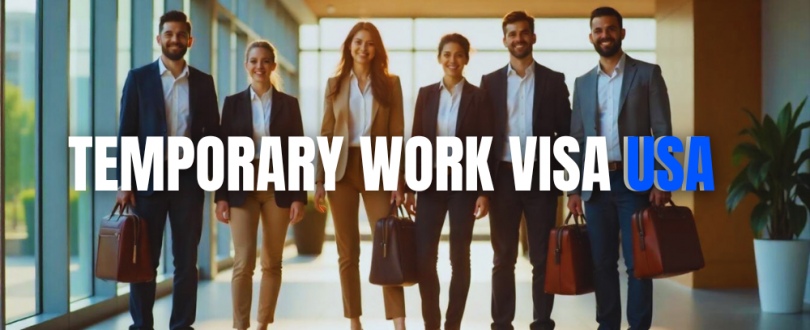
The United States temporary work visa is a gateway for skilled professionals, seasonal workers, and specialized talent to contribute to the American economy. It plays a pivotal role in addressing labor shortages, enhancing innovation, and creating a dynamic workforce. In this comprehensive guide, we will walk you through all major aspects of securing a temporary work visa for the USA—eligibility, visa types, application steps, employer obligations, and more.
What Is a Temporary Work Visa USA?
A temporary work visa for the United States permits foreign nationals to work in the U.S. for a fixed period under a specific employer. These visas do not grant permanent residency but provide an opportunity for legal employment and, in some cases, a pathway to long-term immigration options.
There are various categories of temporary work visas, each tailored to the nature of employment, industry requirements, and qualifications of the applicant.
Most Common Types of Temporary Work Visas in the USA
H-1B Visa – Specialty Occupations
The H-1B visa is the most sought-after temporary work visa. It is designed for foreign professionals in specialty occupations such as IT, engineering, finance, healthcare, and science.
Key Features:
– Requires a bachelor’s degree or higher in a specific field.
– Valid for three years, extendable to a maximum of six years.
– Subject to an annual cap of 65,000 regular and 20,000 for advanced degree holders from U.S. institutions.
– Employer must file a Labor Condition Application (LCA) with the Department of Labor.
L-1 Visa – Intra-Company Transfers
The L-1 visa is for employees of multinational companies being transferred to a U.S. office.
Types:
– L-1A for managers and executives.
– L-1B for employees with specialized knowledge.
Key Points:
– Employer must have a qualifying relationship (parent, branch, affiliate).
– Must have worked for the company abroad for at least one continuous year within the past three years.
– Initially valid for 1 to 3 years, extendable up to 7 years.
O-1 Visa – Individuals with Extraordinary Ability
The O-1 visa is intended for individuals with extraordinary abilities in the sciences, arts, education, business, or athletics.
Important Details:
– Requires a demonstration of national or international acclaim.
– Must be supported by evidence such as awards, media coverage, or high salary.
– Valid for up to 3 years, with 1-year extensions possible.
H-2A and H-2B Visas – Agricultural and Non-Agricultural Workers
– H-2A: Temporary agricultural workers for seasonal farm jobs.
– H-2B: Temporary non-agricultural workers, such as in hospitality, landscaping, and construction.
Eligibility:
– Employer must prove a shortage of U.S. workers.
– Must obtain a temporary labor certification from the Department of Labor.
– Typically valid for up to 1 year, renewable up to 3 years.
TN Visa – NAFTA Professionals (Canada and Mexico)
Available to citizens of Canada and Mexico under the USMCA (formerly NAFTA) agreement.
Features:
– For specific professional occupations such as engineers, scientists, teachers, and accountants.
– Requires proof of qualifications and job offer.
– Issued for up to 3 years with unlimited renewals.
Eligibility Requirements for Temporary Work Visas
While each visa type has specific criteria, general eligibility includes:
– A valid job offer from a U.S. employer.
– Proof of educational and professional qualifications.
– Demonstrated non-immigrant intent, unless applying under dual intent categories like H-1B or L-1.
– Employer sponsorship willing to comply with wage, labor, and regulatory requirements.

Steps to Apply for a Temporary Work Visa USA
1. Employer Files Petition
The U.S. employer must file the appropriate petition (e.g., Form I-129) with U.S. Citizenship and Immigration Services (USCIS).
2. Labor Certification (If Required)
Some visas, like H-1B and H-2B, require a certified Labor Condition Application (LCA) from the Department of Labor.
3. USCIS Petition Approval
Once USCIS approves the petition, the applicant receives a Form I-797 Approval Notice.
4. Visa Application (Form DS-160)
The applicant submits Form DS-160 online and pays the visa fee.
5. Attend Visa Interview
Schedule and attend an interview at a U.S. embassy or consulate. Bring all supporting documents.
6. Visa Issuance
Upon approval, the visa is stamped in the passport, and the applicant can enter the U.S. to begin work.
Required Documents for Visa Application
– Valid passport
– Form I-797 (petition approval)
– Completed DS-160 confirmation page
– Visa appointment letter
– Job offer letter from U.S. employer
– Educational certificates and transcripts
– Resume/CV
– Proof of non-immigrant intent, if required
Employer Responsibilities and Compliance
U.S. employers sponsoring temporary workers must:
– Pay the prevailing wage for the job location.
– Maintain proper documentation and records.
– Avoid discrimination or exploitation.
– Notify USCIS of any significant changes in employment.
– Non-compliance may result in penalties, revocation of petitions, and restrictions on future sponsorships.

Changing or Extending Status While in the U.S.
Temporary workers may request:
– Extension of stay by filing Form I-129 before the current visa expires.
– Change of employer, which requires a new petition.
– Adjustment of status, if eligible for a green card under family, employment, or investment categories.
Dependents of Temporary Work Visa Holders
Spouses and unmarried children under 21 may apply for dependent visas:
– H-4 for H-1B dependents.
– L-2 for L-1 dependents, which may allow work authorization.
– O-3, H-4, and TD (for TN visa holders) do not automatically allow employment, but work permits may be obtained in certain cases.
Tips to Improve Approval Chances
– Submit complete and accurate documentation.
– Ensure the employer’s credibility and good standing with USCIS.
– Prepare thoroughly for the visa interview, especially regarding job role and qualifications.
– Use a qualified immigration attorney for complex cases.
FAQs About Temporary Work Visas
Q1: Can I change employers while on a temporary work visa?
Yes, but your new employer must file a new petition.
Q2: Can my spouse work in the U.S.?
Depends on visa type. For example, H-4 spouses (H-1B dependent) can apply for EAD.
Q3: What happens if I lose my job?
You typically have 60 days to find a new employer or change status.
Q4: Can I study while on a work visa?
Yes, but it must be part-time and shouldn’t interfere with your job.
Q5: Is premium processing worth it?
If you’re on a tight schedule, yes. Decisions in 15 calendar days.
Q6: Are there quotas for all temporary visas?
No. Some, like H-1B, have annual caps. Others like O-1 or L-1 do not.
Conclusion
The temporary work visa USA system offers a structured legal path for skilled professionals and laborers to contribute to the U.S. economy. Whether you’re an engineer, scientist, artist, or seasonal worker, there is a visa route tailored for your role. It is essential to follow the proper procedures, maintain compliance, and stay informed of evolving immigration policies.

